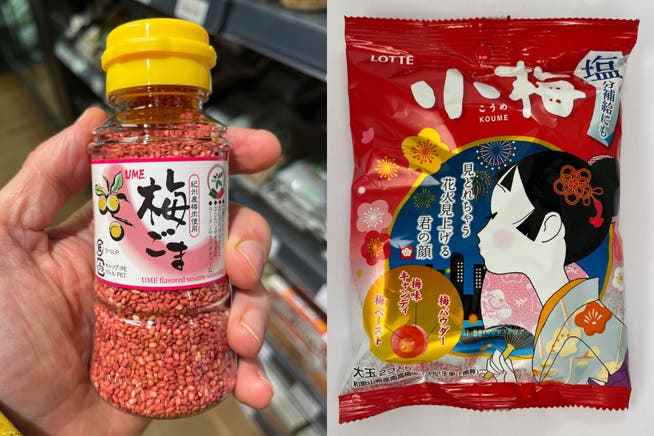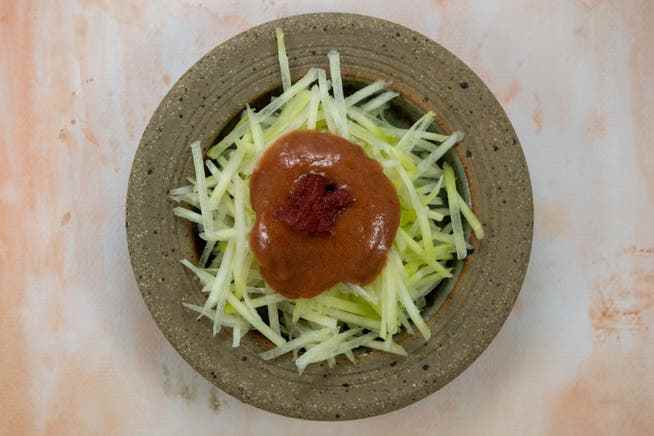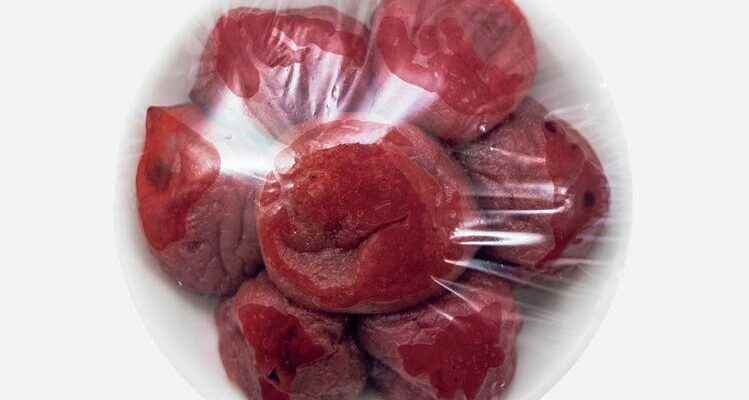With us, the umeboshi is just a discreet ingredient in many a sushi dish. In Japan, however, the salty plum enjoys cult status and is used in a variety of ways in the kitchen.
Now the little blonde got what she wanted after all. For a long time she had to tug at her father’s shirt, who was busy photographing the luxurious fruits in the extravagant food hall of the Mitsukoshi department store in Ginza. Finally he gave in, because after all you don’t come to Tokyo every day. He has been drawn by his little daughter to a small stand that sells cherry-violet chocolates or sweets, individually wrapped in pink paper bags with gold letters on them. He took three parcels from the saleswoman, slipped two into his waistcoat pocket and handed the third to the daughter.
She now tucks the Barbie doll under her arm, whose hair is also dyed cherry purple, and starts to open the bag.
But the clasp is tough, so she puts the doll in Daddy’s hand, spreads her legs and gets down to business with full concentration. Dad wants to pull her a little to one side because she is standing in the middle of the market’s central axis. But she shakes his hands off in annoyance and twists her face into a grimace. So the father turns back to the cubic watermelon, which you could buy here for as little as two hundred francs.
The paper finally gives way. The little girl slips her fingers through the slot and pulls out the piece. The wrinkled surface is reminiscent of Japanese ceramics, perfection of the irregular. But the color promises sheer sweetness. The girl carefully puts her prey on her tongue, which is also blue-violet, probably from another treat she was just gorging on. She closes her mouth and eyes. Pure bliss spreads across her features.
But then: What is that? The child’s face becomes a grimace, the mouth opens and a torrent of cherry-violet drool shoots out horizontally. The ladies and gentlemen, who were just happily examining the extravagant displays, freeze, and all eyes fix on the bluish puddles on the white tiles. In the middle, half bitten, the praline, which itself looks pale.
Curiously, Marcel Proust comes to mind at this point, and I wonder how his story would have continued if his protagonist had simply spat the bitten Madeleine back onto the table.
For a moment it’s very quiet in the center of the food hall. Only soft jazz music hums out of the loudspeakers. Is that really Bill Evans? But then a little mother in a pink uniform pushes her way through the dark suits of the customers, approaches the heap with a thousand bows and sweeps it into her little shovel with a trembling hand. The father grabs his daughter’s arm and flees. The first customers who find their way back to movement avoid the spot where the praline was lying, but soon everything goes back to normal.
I stroll towards the stand with the cherry-purple candies. When the clerk sees me coming, she tears open a package with feverish haste and hands me a tiny corner of the shriveled thing on a toothpick, the back of which is carved like a small samurai sword. I put the piece in my mouth. It does taste like fruit, but it’s quite sour and, above all, so salty that I briefly feel the impulse to spit it into my hand. I behave, swallow and smile.
“Umeboshi,” says the saleswoman in a low voice: “Little plum, very good with rice and very good for health.”

A variety of products made with umeboshi can be found in Japanese specialty grocery stores: pastes, sauces, rice side dishes and even (really sweet) candies.
Several years have passed since that incident in the Ginza food hall. The girl has certainly long since become a young woman. Do you think she remembers her performance in Tokyo when she eats nigiri or enjoys maki rolls for lunch like millions do every day?
Because in the realm of sushi, the sour-salty plum is most common outside of Japan, as an efficient flavoring ingredient in combination with lots of rice and other ingredients. In Japan, however, plums are also enjoyed pure, they are considered the queen of all pickles. A bowl of rice with an umeboshi in the middle is considered to be something like the most elementary form of a Japanese dish – and of course also reminds of the Japanese flag.
Umeboshi are traditionally made from the apricot-like ume fruit, which is fermented in wooden vats with up to 25 percent salt, much like sauerkraut. After about six weeks, perilla leaves are added, which contain a red dye that they pass on to the fruit during a ripening period of up to two years. The result is wrinkled, cherry-violet and highly aromatic fruit pralines, which I use like a spice in the kitchen where salty, sour and fruity notes are desired.
Incidentally, these fruits are also called umeboshi in German encyclopedias, alternatively they are sometimes called salt plums. But who wants to put a salt plum in their mouth when they can say umeboshi? Salt plum sounds like an insult, but umboshi like a caress, like a word for an absolute delicacy. However, words are probably a matter of taste. And the young lady from the food hall in Ginza would probably have a slightly different position.
Umeboshi Salad Dressing

With umeboshi, a fruity salad dressing can be made in no time at all, which also goes well with raw vegetables with some fish. In the picture umeboshi salad dressing on white carrot.
You can use umeboshi to stew wonderful meat dishes or give vegetables, tofu and fish a “Japanese twist” without much effort. I also like to make a salad dressing with the sour fruits, which (if you leave out the water) also works as a dip and can be varied endlessly.
For 2-4 servings of salad
- 6 umeboshi, pitted
- 1 tbsp soy sauce
- 2 tbsp canola oil
- 2 tbsp water
preparation
- Puree all ingredients and serve with hearty salads. Instead of rapeseed oil you can also use grapeseed oil or experiment with olive oil etc.
